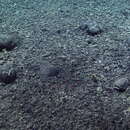en
names in breadcrumbs


“7. Convexella Bayer, 1996
FIGURE 5A–I
Primnoella.—Studer, 1887:51 [in part].—Wright and Studer, 1889:83–84 [in part: Convexae].—Versluys, 1906:51 [in part: Convexae].—Kükenthal, 1908:12–13 [in part: Convexae]; 1915:148 [in part: Convexae, in part, key to genus and species]; 1919:384–386 [in part: Convexae, in part, key to species]; 1924:279–280 [in part].—Madsen, 1944:39.—Bayer, 1956:F220 [in part]; 1981b:936, not 938 [= Primnoella] [key to genus].—Bayer and Stefani, 1989:455 [in part: key to genus].
Convexella Bayer, 1996b:171–180.
DIAGNOSIS. Colonies usually unbranched (flagelliform) or sparsely dichotomously branched. Calyces arranged in whorls of up to 15 (Figure 5b), each calyx round in cross section and inclined upward or perpendicular to axis. An inconspicuous operculum consisting of 6–10 opercular scales is present (Figure 5a, f–g), often hidden from view by the eight infolded marginal (= circumopercular) scales; operculars smooth on inner surface. Marginals arranged in two circles of four that alternate with one another, the circumference of the distal polyp not being large enough to accommodate eight marginal scales. Polyps protected by eight complete longitudinal rows of body wall scales, four of which can be seen in abaxial view. Body wall scales not paired but alternate with those of adjacent rows, appearing to spiral around calyx. Coenenchymal scales in two layers: outer layer composed of smooth, rounded scales; inner layer composed of small, irregularly shaped tuberculate rods.
DISCUSSION. As mentioned in the discussion of the genus Primnoella as well as in the publications of Bayer (1996b) and Cairns (2006), species now placed in the genus Convexella had been placed in the species group “Convexae” of Primnoella. Bayer (1996b) finally separated fi ve species (Table 4) from Primnoella to form the basis of Convexella, the latter differing in having calyces round in cross section, eight rows of equal-sized body wall scales and thus no naked adaxial region, four rows of body wall visible in abaxial view, and calyces inclined (not appressed) upward. The species are briefly reviewed by Bayer (1996b).
DISTRIBUTION. Antarctic, subantarctic South America, Kermadec Trench, North Atlantic, 12–5,850 m, C. krampi being the deepest known primnoid.
TYPE SPECIES. Primnoella magelhaenica Studer, 1879, by original designation. Type assumed to be deposited at the ZMB. The type species is well described and copiously illustrated by Bayer (1996b)."
(Bayer & Cairns, 2009)
Convexella is a genus of corals belonging to the family Primnoidae, first described by Frederick Bayer in 1996.[2][3][4]
and from the Australian Faunal Directory:[5]
Convexella is a genus of corals belonging to the family Primnoidae, first described by Frederick Bayer in 1996.
Species from WoRMS:
Convexella divergens (Hickson, 1907) Convexella jungerseni (Madsen, 1944) Convexella krampi (Madsen, 1956) Convexella magelhaenica (Studer, 1879) Convexella murrayi (Wright & Studer, 1889)and from the Australian Faunal Directory:
Convexella vanhoeffeni (Kükenthal, 1909)